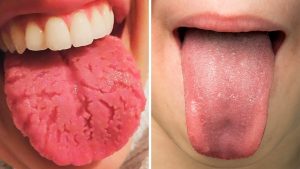 What Your Tongue Says About You
What Your Tongue Says About You
A normal healthy-looking tongue is pink with small bumps, or papillae, that cover your taste buds.
While there are several harmless, and easily remedied deviations, changes in texture or color can say a lot about your health. Common culprits of changes with your tongue are aging, medications, infections, and stress, but certain variations may also serve as warning signs that something is medically wrong.
Take a look at your tongue in the mirror, and if you see any irregularities, review the scenarios below, and give our Dental Group at New Look Dental a call to get your tongue back in the pink.
A Coat of Many Colors
The only coat we like to see at New Look Dental is one you would hang in a closet, and while brown may be the new black, either color on your tongue will never be in fashion. A tongue bearing a brown, white, yellow or black “coat” can be a good predictor that something is going on internally that demands a second look.
White tongue is often triggered by use of alcohol or tobacco, dry mouth, dehydration, mouth breathing or medications like antibiotics. Oral thrush infections as a result of illness or a bacterial imbalance, candida or fungal overgrowth can also cause white tongue. It is rarely a dental emergency and may be easily corrected through regular tongue scraping and taking probiotics.
If this doesn’t work, please skip alternative remedies, such as ingesting garlic and sea salt, or oil pulling, and schedule a consultation with the dentist or doctor, as more serious conditions may be present.
White lacy patches could be due to lichen planus from an overactive immune system, while a flat, hard white coating could be leukoplakia, a possible symptom of cancer. A black tongue can simply occur from taking an antacid containing bismuth and easily eliminated with discontinuation of the medicine. A red tongue can be a symptom of scarlet fever or Kawasaki disease, which involves inflamed blood vessels.
A Hair Out of Place
New Look Dental prefers to see hair on your head, versus on your tongue, as white, brown or black hairs on the tongue, called hairy tongue, are actually protein strands produced by bacteria from food getting caught. Brushing and scraping should fix this, but if not, could signal another form of leukoplakia due to HIV or Epstein Barr virus.
A Tongue Road Map
A smooth, glossy red tongue accompanied by pain can indicate a vitamin and mineral deficiency, such as Vitamin B3, folic acid or iron, brought about by celiac disease, medications or infections.
Geographic tongue where the tongue texture has both smooth and bumpy areas that may burn or feel painful, can be caused by lichen planus or psoriasis.
Canker sores, another change in the texture or “topography” of your tongue that appear like small reddish bumps or moon craters, are quite painful, intermittent, and can be triggered by biting yourself, certain foods and stress.
Tongue irritation can cause lingual papillitis or “lie bumps” on the tip of the tongue, and different viruses can cause bumps on the sides and tip.
Tongue on Fire
Naturally, if you bite or injure your tongue you will experience a lot of pain as the tongue is equipped with multiple nerve endings. Several of the minor conditions discussed above (geographic tongue, lichen planus and thrush) also cause pain, as will certain medications and infections.
Burning mouth syndrome where your tongue feels like it has been scalded, and has a bitter or metallic taste, could point to acid reflux, diabetes, dry mouth, infections, or issues pertaining to the nerves, or, acid-based foods, candy, gum, mouthwash or even your toothpaste.
Oversized Tongue
Imprints on the sides of the tongue indicate your tongue is enlarged (macroglossia), which could be caused by allergies, an infection or hypothyroidism.
Groovy Tongue
We like all things groovy from the 60s and 70s as much as the next guy, but not groovy tongues. Fissured or groovy tongues, while harmless, are attributed to aging, psoriasis, Sjögren’s syndrome or Down Syndrome. As your dentist always recommends, gently brush and floss to remove culprits like bacteria and food debris to correct this.
For persistent issues such as difficulty chewing, swallowing, swelling, lumps and pain in your mouth that lasts more than two weeks, call your dentist right away as these could be a more serious problem like cancer.



